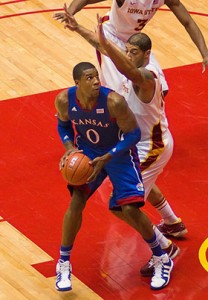Yesterday, Kent posted the results of our Elimination Roto Draft (and here is part II), a 20-team league with a wonderful quirk that Jeff, Kent and I are all members of. This is my first year in Elimination Roto for basketball but I’ve participated in a similar baseball league.
The format imposes a couple of unusual constraints on drafting, but generally the lessons we can draw from this draft are similar to those for normal roto drafts. I wanted to draw three out specifically, from my experience Tuesday night, that are applicable to all fantasy drafting. I have to relearn these all the time, as I found out to my cost; and also somewhat to my benefit.
I spoke in the comments to Kent’s piece about the difficulties of picking on the ends of a snake draft, which is that you will target players and never have a chance to draft them. This is especially true of snake drafts in deep leagues; with 32 players going between some of my selections, there was simply no way to obtain some guys in an advantageous position.
My draft went as follows:
- 17 Kyrie Irving
- 24 Blake Griffin
- 57 Tyson Chandler
- 64 Tyreke Evans
- 97 Lou Williams
- 104 George Hill
- 137 Drew Gooden
- 144 Thomas Robinson
- 177 Nick Young
- 184 Zaza Pachulia
- 217 Amir Johnson
- 224 C.J. Miles
- 257 Enes Kanter
- 264 Josh Childress
- 297 Jermaine O’Neal
- 304 Earl Watson
The first lesson isn’t one of the three, it’s lesson zero: be lucky. There’s no substitute! As Jeff has noted in the comments to Kent’s piece, there was no reason to hope or expect Kyrie Irving to slide to the #17 pick. The upside risk here is tremendous, and I was just lucky that he fell.
Lesson One: Understand Your Format
 20-team elimination roto, as I mentioned earlier, has some interesting constraints. A good example of how those impact a draft is how it impacts my draft of Thomas Robinson in the 8th round, 144th overall (right around the end of a standard format 12-team league like a Yahoo! public league).
20-team elimination roto, as I mentioned earlier, has some interesting constraints. A good example of how those impact a draft is how it impacts my draft of Thomas Robinson in the 8th round, 144th overall (right around the end of a standard format 12-team league like a Yahoo! public league).
You need to survive the early months in elimination roto, because finishing in the bottom two spots in any month ends your season. However, you want to be able to save games played early in order to move up in the mini-drafts. Therefore while you’d like to take some players likely to start slow (or who will be hurt early) and stash them for when you’ll be piling up numbers, if you do too much of it you will be burned.
Both of those went into picking Thomas Robinson at 144. He’s probably a little better than that; I think of him as a 10th- or 11th-rounder in a normal 12-team league, so around #110-125 overall. But since I was picking him with a top 8 pick I had a dilemma. Was it too early to take a guy who might be mostly sitting and learning in November and December? Knowing I had good power forward coverage in Drew Gooden and Blake Griffin, I felt safer in taking him. I think he’ll pay dividends down the line. But still, it’s going to hurt to have my #8 rotation guy playing light minutes early in the season, and I may need to scramble if I get out of the gate poorly.
The same need for knowledge of your format applies to your categories in roto or head-to-head. I think Tyson Chandler at 57 is something of an overreach most of the time, but crucially our league counts both offensive and defensive rebounds, something not every league does (the default Yahoo! public league settings, for example, count only total rebounds). I felt much better taking Chandler there and will benefit from his high field-goal percentage as well, particularly since I have some shot-happy guards.
Think early, before the draft, about your format and let it help plan your strategy. This draft came so early that I hadn’t really done that yet, although I improvised reasonably well. I still left myself short; I had a panic buy of C.J. Miles in the 12th round because I needed someone to go to for minutes and counting stats in case several of my risky picks don’t pan out early. (Early in the season is the hardest time to scour the waiver wire).
Lesson Two: Draft What You Know
This was one thing I did well. The most noticeable thing about this draft is that I have already written about seven of my top eight draftees in this space in the past month.
Warren Buffett, in his Chairman’s Letters, writes often about how when he is picking public stocks to purchase for Berkshire Hathaway, he usually disdains the opportunity of picking tech stocks. This hurts his performance against the market in some years and helps him in many more. Why no tech stocks? It’s nothing to do with the companies themselves or any opinion about the long-term value of the industry. It’s simply because he doesn’t understand the tech very well, and if he doesn’t understand the tech he doesn’t understand the business, and if he doesn’t understand the business he can’t evaluate the price.
In other words, buy what you know.
(By the way, those Chairman’s Letters are a fantastic education in finance as well as in critical thinking. A great read.)
The lesson for fantasy players in a draft is obvious. You will often have much better knowledge about some players than others. Use it! In writing previews of the Pacific and Central divisions, I did a lot of research on the players. In writing a Jump Ball on Lou Williams, I did the same. In your case, you’ll have done the same to a greater or lesser degree: you read about or watch some players much more than others. You know who is a bargain and who is a dog; so when you are evaluating those players, you have much more price certainty. Yes, ultimately the market knows a lot, but it doesn’t know everything. It’s important for you to check your knowledge and understanding against what others know and to try to be objective. At the same time, you’ll know best — sometimes better than anyone else in your draft — about certain players. Use that advantage. You can draft perfectly well in a fantasy draft, for example, by studying one conference twice as hard and the other one hardly at all.
I followed the same principle in taking Amir Johnson in round eleven. As a Raptors fan, I think I have a good idea of his strengths and weaknesses, those of his teammates, and how that is likely to play out during this season. I draft him with eyes open (and at any rate, most of you won’t need to evaluate the 217th pick since you won’t have one) and knowing he can help balance a potential weakness thanks to my high-risk pick of Thomas Robinson.
Don’t be afraid of your knowledge. It’s all you have.
Lesson Three: Plan for Emergencies
You’ll have noticed that I dribbled the last three picks off my foot out of bounds. In mitigation: I wasn’t there, folks.
Things happen in fantasy drafts. Your computer goes ‘futz’. Your wife or girlfriend or boyfriend drags you away. Or, in my case, I had to attend to the children’s bedtime. And yes, I had lost track of time. So I hit the autopick box in the Yahoo! draft widget, closed my eyes, and hoped for the best.
But I was in the midst of making a list for the end of the draft when I did it. This was shortly before the Kanter pick; I had him top of my queue and was hoping he’d drop. I love Kanter, who had an extremely effective backup role last season and is a developing offensive threat; other than Irving and Evans, he’s my favorite pick of the draft.
But the rest of my queue was a disaster, because it wasn’t sorted and I had just started pulling guys off. As a result, I lost out on several players I’d rather have taken, such as Charlie Villanueva and Jordan Hill. Childress and O’Neal were on my list to look for with the 16th and last pick; instead I had them in Rounds 14 and 15 and got an Earl Watson autopick from the computer with the last one. In the grand scheme of things, the 14th, 15th and 16th picks in this format don’t amount to anything because even if they start the season with me they will be gone after the first month. So I use them to take upside players, to take a chance on something good. Now I’ll need to scour the waiver wire, although I’m keeping Childress, a talent who has lost his way, for the time being.
Plan for emergencies. Keep that queue full of players as you draft and make sure they are reasonably sorted. If I’d been dragged away in the sixth round and not the 13th, I’d have faced drafting disaster.
Thanks to Dirk Hansen for the picture of Thomas Robinson.

Those are all great tips.
I think you had a solid draft. Not as good as Kent but not elim territory either. As an experienced elim guy, you need to think of your guys in one of three roles: Core – the guys you want to start for 82 games – should be at least 6 and cover all five positions. I think you achieved that 1-7 though you are a little shy on 3P but that’s a very correctable cat. Support – the guys who you can play if you need to (whether due injury or tactically) – these guys should be format friendly and help but not hurt types like Amir Johnson. If you made a mistake its with Nick Young and CJ Miles who can kill your FG% with one bad game. They have to breakout to have value. The third type are long term upsides – these are the guys you are stashing for later in the year when you are deploying all roster spots. Thomas robinson and Enes Kanter fill that bill nicely.
There are no late round mistakes in this format because you have to cut someone after each mini-draft anyway. It is the very rare 15th round pick that survives the first elimination draft.
I hear you, Josh. I mean, look at that draft; yes, it was an autopick accident but I had added Jermaine O’Neal to my queue and I firmly believe he’s a candidate as the worst player in the NBA. But deep leagues are fun as a result.
I had a 16 team NFL Fantasy league once and it was scary how far into the depths of badness we had to go.